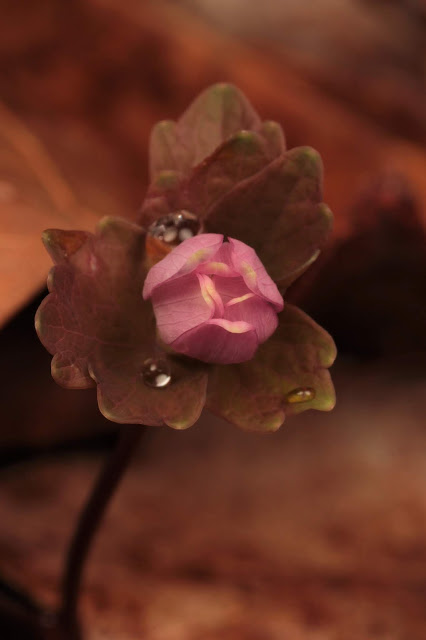 |
| A cluster of white trout lily, Erythronium americanum, erupts from a sheltered spot on a Dolostone cliff. |
It's that wonderful time of year when new things are hopping, growing, popping, unfurling and otherwise returning to the business of growing and reproducing. Everywhere you look, (if you know where and how), some wonderful thing is happening outside your door.
Outside our doors here on the Preserve, it's time for the earliest of spring wildflowers. Especially on the sunny southern slopes there can be an abundance of lovely plants to discover. However before we throw ourselves into that abundance, I feel obligated to mention that the ever interesting skunk cabbage is the first wildflower to bloom. It often can be found emerging through snow in late January or February depending on where you are and the severity of the winter.
 |
| This skunk cabbage flower, Symplocarpus foetidus, seems to be an older specimen already beginning to soften and decompose. Its associated leaves still tightly coiled, are ready to open and photosynthesize their little hearts out! |
One thing that is easy to overlook this time of year is the beauty that comes with plants just as they emerge from the warming soil on the forest floor or in many cases here on the preserve, the warming pocket of soil on a large Dolostone slump block. Many times these plants have dark colored leaves just as they come up. Perhaps the darker color helps absorb the heat energy from the sun even on overcast days.
 |
| These trout lily leaves are still a darker purple color. A couple haven't even flattened out yet. |
 |
| These Dutchman's breeches, Dicentra cucullaria, leaves are deeply cut giving it a fringey appearance as it pokes through the leaf litter. |
 |
| The leaves of Virginia bluebells, Mertensia virginica, are dark blueish green with purple veining at first emergence. |
Another thing that can be overlooked - but shouldn't - is the budding and opening of the flowers themselves. The structure of a flower is an extraordinarily beautiful thing even before it opens. Not only that, but the endless variety of leaf shapes and forms are worth paying attention to as well.
 |
| The serrated leaves and tightly bunched buds on this cut-leaved toothwort, Dentaria laciniata, are striking. The tiny glimpse of color at the top of some of the buds is an added bonus for those who look closely. |
 |
| These two bloodroot flowers, Sanguinaria canadensis, are like rockets waiting for lift off. Notice the leaf on the one in the front hugs the flower bud protecting it from low temperatures. |
 |
| This trout lily boasts graceful lines as it unfurls. It's a unique look at a familiar wildflower. I'm glad I didn't pass it by because it wasn't in full bloom. |
 |
| Virginia bluebells are a favorite among many wildflower enthusiasts. It's easy to see why. Even without the full bloom of this showy woodland gem it's a showstopper. |
Once the flowers are in full bloom one would think it's just eye candy all the time. Think again! Early spring is a wild time weather wise. One day can be warm and rainy the next can be cold but sunny. Back and forth swings of temperatures clouds and sun make it a tumultuous time for both the flowers and their pollinators. Many early spring wildflowers are only open during sunny days. This helps to save energy for the times when pollinators will most likely be out. Again, it's easy to overlook a closed up flower, but slowing down and taking a closer look can be rewarding.
 |
| Here are our blueish hepaticas again, but not looking sleepy any longer! What a transformation! |
 |
| Rue anemone delicately open and quivering with the slightest breeze. |
 |
This is one of the yellow corydalises, Corydalis spp. Thier lacey foliage and arching stems are very attractive. These sprays of golden flowers are very at home on boulders and rocks on the Preserve.
|
 |
| The purple cress is open for business! |
 |
| The bloodroot is finally blooming and will only last a day or two. This flower really knows how to put on a show with it's whiter that white petals and golden yellow anthers. |
 |
| These Dutchman's breeches are also sporting white and yellow, but they have found that a more interesting shape works best for them. This early spring flower is a favorite of queen bumblebees, Bombus sp. |
Posted by: Robyn Wright-Strauss

















